by Winding Pathways | May 1, 2025 | Birds, Flowers/Grasses, Nature
A woodland stroll is outstanding in any season but is best during May’s first ten days. We always marvel at nature’s fleeting changes that happen swiftly.
Why Early May
Late April and early May are when ephemeral flowers revel in their time in the sun. That long word “ephemeral” means a short time. There’s a brief time in late April through about mid-May when the air and soil are warm but trees haven’t yet leafed out. So, sunlight streams through still naked branches to reach the ground.
Bloodroot, trout lily, anemone, Dutchman’s breeches, ginger, trillium, and May apples, among many of the woodland flowers, take advantage of this window of sunshine. They grow amazingly fast, bloom for a short time, and then seem to disappear for the rest of the year. They are there but hard to see and not in bloom during summer’s heat and winter’s chill.
-
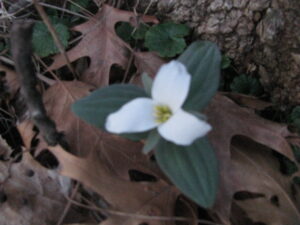
-
An early bloomer
-
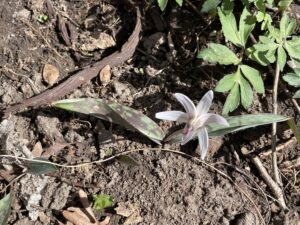
-
Trout Lily can form carpets in dappled shade.
-

-
Mayapples carpet the forest floor.
-
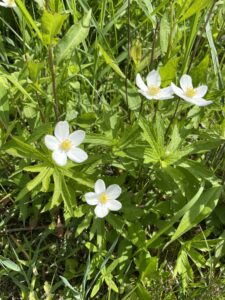
-
A sunny center surrounded by white petals.
-
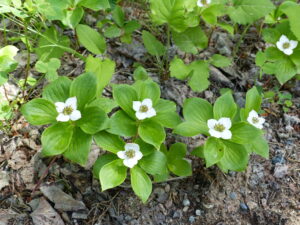
-
Bunchberry forms a lush, carpet on moist soils.
-
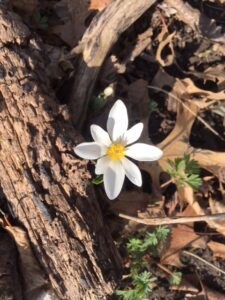
-
When broken, the stem oozes a reddish sap.
Other Delights
Enjoying wildflowers is only one of early May’s woodland delights. Another is birds.
Many of them are, like wildflowers, ephemeral but in a different way. They are migrants en route from points way south to breeding areas up north. For only a few days, often in early May, they linger to feed, rest, and sing before continuing their journey.
We always look forward to seeing migrating birds on their way north and others that come north to nest near our home. Flowers are easy to find. They can’t hide. Birds can, and often many fascinating birds are hard to spot but easy to hear as they sing in what seems like springtime joy.
-
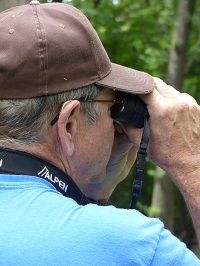
-
Bird watching is again a joy with hearing aids.
-
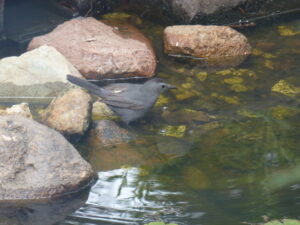
-
A catbird drinks by a pool.
-
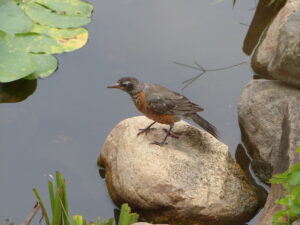
-
Keeping a wary eye, the robin cautiously gets a drink.
-

-
Hummingbirds zoom up, down, and sideways all summer. Then, head south.
-
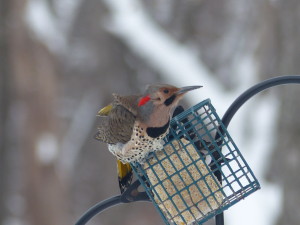
-
Winter is tough on birds so keep your feeders full.
-
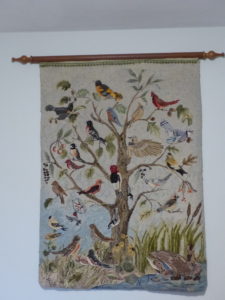
-
A hooked rug by Yvonne Fellows
Modern Technology Helps
Identifying flower and bird species is a fun activity that modern technology has made relatively simple. We use phone apps to help identify plants and birds. Many are free.
Plants: SEEK is amazing. SEEK is part of an electronic world called iNaturalist. It works for many domestic plants as well as wild ones. Load the app, open it when encountering an unknown plant, take a photo, and SEEK can usually accurately identify it.
Birds: We love the Cornell University Lab of Ornithology’s Merlin Bird ID app. It includes a sound identification tool. So, when we’re in the woods, prairie or marsh and we hear birdsong we can’t identify, we turn on Merlin and select the sound feature. It identifies what’s singing. Merlin also includes photos and information on each species.
We hope you take in the annual show. Early May is the best time to be outside. Enjoy and remember.
by Winding Pathways | Apr 17, 2025 | Geology/Weather, Nature, Travel/Columns
Quincy Warmth
After a short walk through deep snow in the bitter cold, we entered a dimly lit tunnel. As we stepped into Quincy Mine’s long tunnel we were surrounded by warmth. Well, the warmth was relative. Outside it was below zero but inside the tunnel was a balmy 43 degrees.
We visited Quincy Mine in Michigan’s Keweenaw Peninsula in frigid February, but if we had been there on a blistering hot August day the mine’s interior temperature would be a delightfully cool 43 degrees. It’s always that temperature in that tunnel deep underground.
No matter the season, the Keweenaw Peninsula is a fun place to visit. It juts upward into Lake Superior. Lake effect snow piles deeply each winter, but in summer the Lake sends cool breezes inland.
“We Do Winter Well”
This claim by Visit Keweenaw advocates is no exaggeration. Residents navigate steep, snowy streets with aplomb. Some travel by snowmobiles to work, take a short spin during lunch breaks, and motor on home after work. They dress warmly and relish the cold. The area welcomes winter visitors who enjoy downhill and cross-country skiing, snowshoeing, snowmobiling, shopping, and meals of grilled lake whitefish and locally made pasties. More about them later. Broom and ice hockey regionally and at the Michigan Technological University draw in families by the dozens. The Huskies, sometimes known as the “Stick Huskies” – think hockey – compete, creating fabulous ice sculptures that dot the campus and area.
-
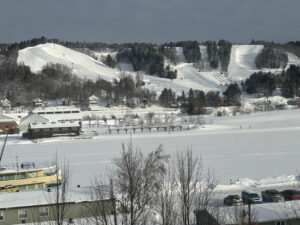
-
Trail groomers started before dawn to groom trils.
-
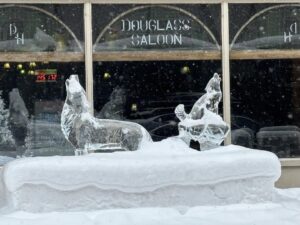
-
ice sculptures dot the town and campus.
-
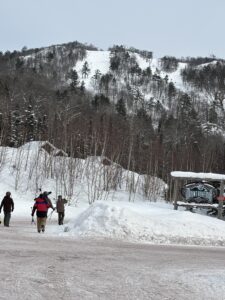
-
BoHo is an ungroomed Black Diamond ski area.
Shopping and dining are equally fun in summer, and warmer weather offers boating, swimming, fishing, and sightseeing. During warm months, visitors can book a ride on boats taking them to the distant Isle Royale National Park.
What and Where Is the Keweenaw?
The Keweenaw is actually a peninsula on a peninsula. It’s attached to the relatively wild Upper Peninsula, but interestingly it’s no longer a peninsula at all. Originally a natural inlet extended most of the way across the peninsula’s base. To facilitate shipping, land was removed, extending the inlet into a canal and making the Keweenaw an island. Today the main towns of Houghton and Hancock face each other across the Portage Canal and are separated by one of the world’s largest lift bridges. In summer, dozens of boats motor by, including some large ones.
Copper Country
For us touring Quincy Mine was a visit highlight. For nearly a century it produced thousands of tons of copper that helped America electrify. Quincy is only one of several that once operated in the area but they all were abandoned when less expensive, open pit mining got established in Utah.
Today Quincy Mine welcomes people to tour its towering surface features that pulled ore up from upwards of 9,000 feet underground. Down that far, the temperatures were blistering 80+ degrees. It was amazing, but we were more fascinated deep down in a mine tunnel when our guide, Clayton Gomez, stopped our small group and doused the electric lights, leaving only one candle to illuminate the vast darkness. “This is how much light miners had as they used muscles to drill into the rock.”
“They’d then stuff blasting power into the hole and set it off. Afterward they loaded the loose stone in carts and pushed it to a shaft where a lift carried it to the surface. It was dangerous and hard work. They earned $2 for a 10-hour shift,” he added. Some of us tried to muscle the heavy cart to little avail.
Initially, the demand was for highly skilled workers in teams of three. One held an iron bar, two alternated hitting the end. In between the one holding the bar, turned it slightly so it would not lodge in the rock. At best this would be dangerous. Done by candle light, required cooperation and skills. Mining innovations changed that. Men worked alone so if an accident happened, they might not be found for hours.
Clayton ended our tour with this thought: “Holes in the ground all we have left to tell the story.” But, he pointed out, copper remains such an important part of our lives. Computers, cars, cell phones.
-
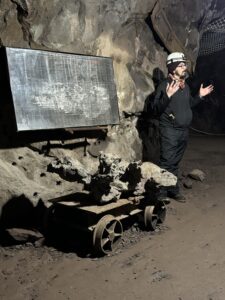
-
Clayton and mine shaft diagram.
-
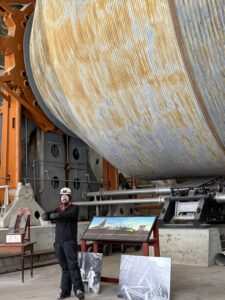
-
Mine shaft drum.
-
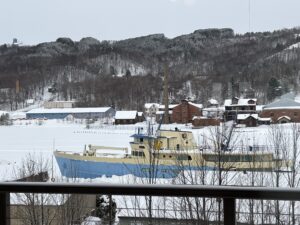
-
Canal. Park Service Boat. Ski run. Quincy Mine Shaft on far hill.
Who Were the Early Settlers and Miners?
The workers, immigrants from the Cornish region, were small, tough, wiry. In the paternalist setting where they received housing and a few amenities, if one got injured or killed, the family was forced to move. After a sweat-soaking shift, the men would change into clothes and step into the sub-freezing weather and trundle home. Only to repeat the process the next day.
Other immigrants from northern Europe arrived and took to the cold, snowy climate. Today skiing and ski jumping are hallmarks of the Nordic heritage. Evidence of the Daughters of Italy, Sons of Norway, Canadian, Finnish and Cornish ancestry highlight the area.
Although mining is now long gone, a delicious traditional food remains. A meat and vegetable pie called a pasty is tasty, nutritious, and portable. (Say the word with a short “a” so as not to confuse with an accoutrement of pole dancers.) Miners would bring this traditional Cornish meal with them as they descended into the pit and enjoy it for lunch.
Many local stores and cafes now sell pasties and we ate several during our stay.
We also enjoyed taking a sauna at Takka Saunas on a frigid day. After sitting in a steamy small sauna building, we dashed out. Marion did the traditional Finnish tradition of laying down in the snow making a snow angel. Rich only stood barefoot in the snow. A sauna part of Finnish culture is fun in any season.
-
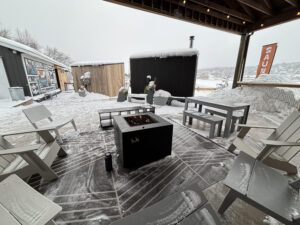
-
Amenities abound
-
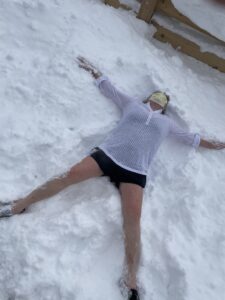
-
Roll in the snow or plunge into cold water.
Keweenaw Mountain Lodge
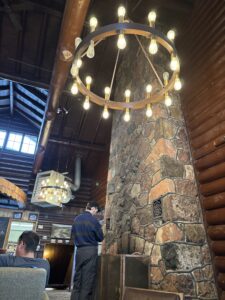
Dark sky and slow travel haven.
Part of our adventure was finding respite at the Keweenaw Mountain Lodge. Some in our group snowshoed. Others lounged in the rustic ambiance. Adjusting to “slow travel” and learning more about the dark sky options. As the lodge owner stated, “We lean into what is authentic and unique.” Heated cabins and groomed trails beckoned. The chef creates delicious picnic baskets and the Tasting Post features a “slow dining” experience. On clear nights the aurora is spectacular.
Jibba Jabba
We went to the Keweenaw for the annual Jibba Jabba Railjam. Dozens of young competitors climbed the manufactured hill in downtown Houghton and took turns sluicing down the steep slope, riding rails, swooshing through the tunnel, and spinning to a stop in front of hundreds of enthusiastic spectators. For days ahead, city crews had hauled in and packed snow at just the right angle on one of the steep streets that are hallmarks of Houghton. The result? Fast speed and thrilling rides down the course.
-
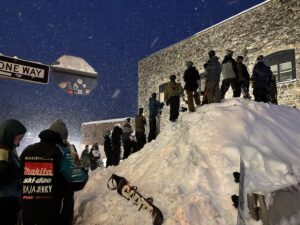
-
Snowy wait
-
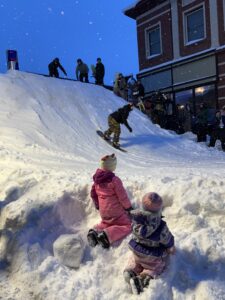
-
Excitement
-
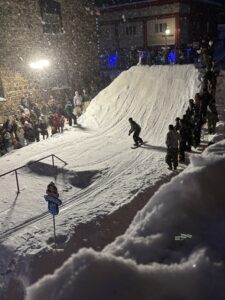
-
Snowy event
Getting There
Five hundred miles north and slightly East is the thumb of the Keweenaw that juts into Lake Superior. Houghton, MI, is Eastern time so we lost an hour. We took two days going, stopping to walk a special labyrinth in Westfield, WI, and overnight at Rhinelander, taking in the Hodag Hunt. These mythological creatures frequent the town and purportedly the nearby forests. We did encounter several in town, which was fun. Eagle River is worth a stop with a terrific coffee shop and amazing annual ice sculptures.
-
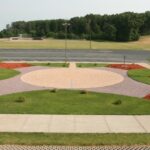
-
The Labyrinth we built as Andy’s Memorial.
-

-
Special labyrinth
After two hours of snowy and scary driving we found clear pavement. Good thing we have advances in car technology and road safety. We stayed on our side of the road because of the center and side rumble strips. No “good ‘ole days” for us. We prefer safe cars and roadways.
We drove back in an easy day as we gained an hour.
-
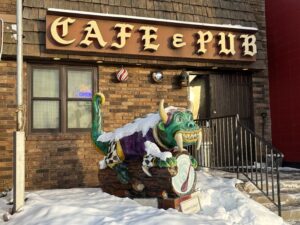
-
Welcome!
-
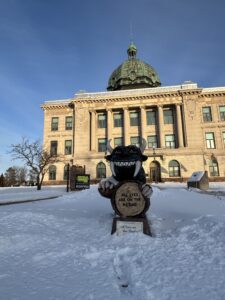
-
Hodag hunt
-
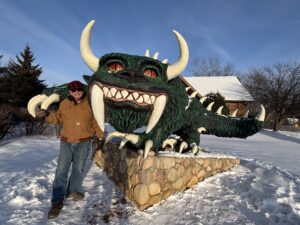
-
A beaten path to the visitor center Hodag.
For information on what to do at the Keweenaw and where to stay check out Visit Keweenaw.
We were there during winter’s icy grip but a future visit during summer’s warmth is in our plans.
by Winding Pathways | Apr 10, 2025 | Amphibians/Reptiles, Nature
Reading a new turtle book stirred memories of Rich’s boyhood near Cedar Lake in New Jersey.
The book, The Natural History of the Turtles of Iowa, by Terry Vandewalle and Neil P. Bernstein is Iowa focused but applies to turtles over a great swath of North America.
Poking Around Cedar Lake
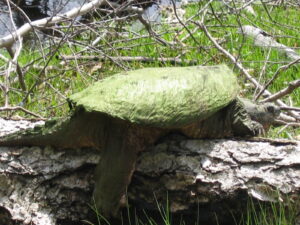
Snappers have powerful jaws.
During his adolescent and high school years Rich spent hours in, on, or around the 99-acre lake. “I remember rowing through a weedy area and pausing to watch a musk turtle walk along the muddy bottom. I’d often see painted turtles, which I called painters, basking in the sun. Every once in a while, the triangular head of a giant snapper would pierce the surface. Then, there were Eastern box turtles and wood turtles that I’d spot while walking,” he recalled.
Although Cedar Lake is a thousand miles east of Iowa, according to the authors our state has musks, snappers, painters, and box and wood turtles, although the last is the Ornate Box Turtle, a Midwestern species.
Turtles of Iowa book
Reading through the new book brought more than pleasant memories. It provided accurate, current information on the natural history of all of Iowa’s wild turtles. It also created sadness at the plight of these amazing and beautiful reptiles.
The book has two general sections. The second and largest is a description of each species found in our state. It’s packed with natural history information and photos of adults, juveniles, and even turtle eggs and nests.
Decline of Turtle Habitat
The first section can leave a reader depressed. Turtles have a hard time living amid the massive habitat changes and direct exploitation caused by people. Although these changes also take place across the continent Iowa, perhaps, is an extreme example.
Turtles that thrive in prairies and wetlands saw their world contract by close to 100% through conversion to row crops, cities, and roads. No habitat, no turtles. They hang on in pockets of appropriate habitat. Perhaps more alarming is the theft of these noble reptiles by people for pets and the turtle meat market. On top of that, many are squashed by cars as they try to cross roads.
No Kidnapping Allowed!
AToo many people can’t seem to resist picking up a box turtle and taking it home. Kidnapping any species, especially turtles, is bad. Caring for a captured turtle is tricky and often results in its death. If it is released away from its home, the animal’s amazing homing ability stimulates a quest to walk home…….and face death on every road it crosses. Some turtles are caught and sold as pets. Others are sold for their meat. Collection is adding population stress to animals suffering habitat loss. Don’t do this! Enjoy them from a distance and let them go on their way.
-
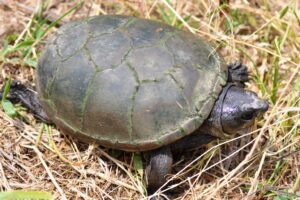
-
Yellow Mud Turtle in grasses.
-
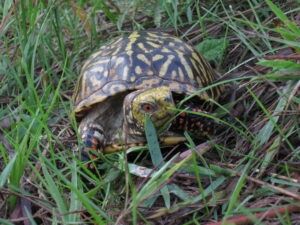
Iowa’s Turtles
Vandewalle and Bernstein graphically describe the plight of today’s turtles while offering hints of optimism. For example, the Iowa Department of Transportation crafted a tunnel under the new Highway 100 near Cedar Rapids. It’s become a safe way for Blandings and other turtles to cross under the busy road.
This book is a good read. This Bur Oak guide is published by the University of Iowa Press. For information or to order it visit University of Iowa Press. It can also be purchased from Amazon.
by Winding Pathways | Feb 13, 2025 | Mammals, Nature
Beavers moved into town. Even a large city like Cedar Rapids.
Surprise
An amazing sight greeted us In December 2024, as we walked a circular trail around a tiny unnamed stream in the heart of Cedar Rapids, Iowa. A beaver dam spanned the narrow waterway. Beaver-felled trees lined the bank while bark-peeled branches floated in the still water.
Nearby were two busy roads, houses, and apartment buildings. Tall downtown buildings were just a mile away. So were factories. These beavers are urban.
-
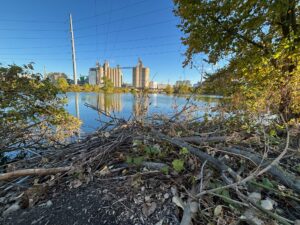
-
Cedar Lake, Cedar Rapids, Iowa.
-
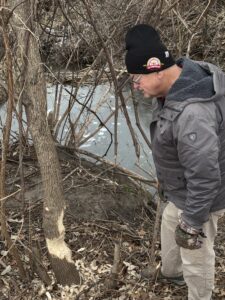
-
A beaver chew next to urban stream.
Urban Beavers
Beavers in a city of 140,000 people! 100 years ago, no one would have imagined that beavers moved into town. But today North America’s largest rodent has moved into cities across the continent. They thrive despite noise and human activity.
Watching City Beavers
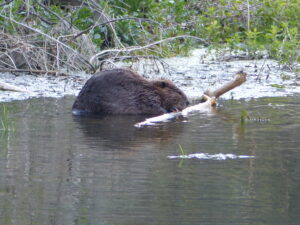
Chewiing
Lots of people enjoy urban birding, and beaver-watching is just as fun. Their territory is easy to find. Fetch a lawn chair, dress warmly, bring binoculars, and perch within sight of beaver activity in the early morning or late afternoon when they’re likely most active.
What to Look For
No animal leaves such visible and durable calling cards as does a beaver family. We walk trails along rivers and often spot trees felled by the sharp teeth and powerful jaw muscles of ambitious beavers. They relish eating the thin nutritious bark covering branches. Beavers leave so much debris around it’s hard to miss finding an active colony.
-
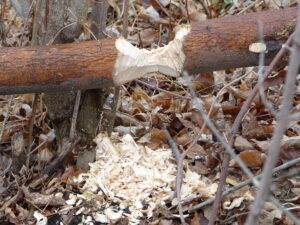
-
chips
-
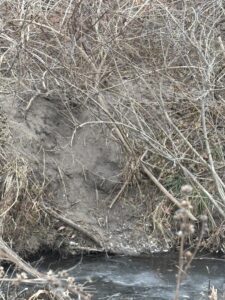
-
Beavers slide
While waiting for beavers to appear keep your eyes peeled. Beavers are a keystone species that alters its environment by cutting trees, digging den holes in the bank, and backing up streams. Their activity attracts many other species, including muskrats, mink, and a host of songbirds that frequent the water’s edge.
An Amazing Resurgence Follows Sad Exploitation
When early Europeans crossed the Atlantic, they found a beaver-filled continent. Experts guess there were somewhere between 60 million and 400 million of the furry animals from coast to coast. That soon changed. European beavers had been hunted and trapped for ages and weren’t common, so newly arrived Americans almost immediately began trapping the huge rodents.
Legendary mountain men combed the Rockies to find plentiful beavers and hundreds of thousands of pelts were shipped eastward in canoes by Canadian voyageurs. Many were shipped to Europe. In the days before synthetic insulation fur kept people warm, and fashionable beaver hats were made from their hair.
Decline and Ethics
The fur trade lasted about 250 years until the late 1800s when the animals had been extirpated from vast parts of their original range. Then came happier news. The value of beaver pelts sank as hats went out of fashion, trees rebounded along streams, and new conservation laws and ethics arose. That started a slow comeback, and now beavers seem to be everywhere.
Two Species
There are two beaver species – the North American and Eurasian. Both are similar but the Old-World species is slightly larger. Each species has made a dramatic comeback. American beavers were released in Finland and Patagonia, where they now thrive as invasive species.
Where Are the Beaver Dams?
Children love reading books about beavers and know that they build dams. Well, not always. These ambitious animals are smart. If their pond, lake, or river is deep enough there’s no need to build a dam. They simply tunnel into the bank to create a home or, sometimes, build a dome-shaped house of sticks and mud that’s usually easy to spot.
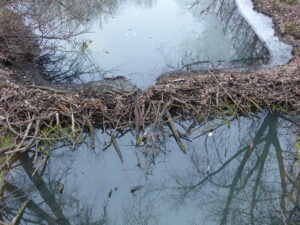
Crossing a small stream.
However, if their stream is narrow and shallow beavers spend nights changing it. They’ll build an amazingly sturdy and often long dam spanning the stream, creating water deep enough for good swimming and hiding a bank tunnel entrance below the surface. Beavers are engineers.
Easy to Watch Urban Beavers
Years ago, beavers were hard to find, even in rural areas. Not anymore. They’re so common in urban areas that people can enjoy them without making a long drive.
by Marion Patterson | Feb 6, 2025 | Nature
On a cold December afternoon Rich bundled up, drove to a friend’s farm, and lugged a lawn chair and hunting gear into the woods. He settled into the chair and sat motionless for nearly two hours. His reward of stillness and dark discoveries was quiet interactions with nature.
Wildlife Carried On
No deer came by but he was thrilled to watch two brown creepers climb up the rough bark of a hickory tree only six feet away. “They didn’t know I was there and I could clearly see them use their tweezer-like bills to dig tiny insects from deep in the bark’s furrows, ” he said.
Minutes later a bluebird perched on a branch around 20 feet away and a gray squirrel scampered within inches of his boots. Chickadees, nuthatches, and woodpeckers went about their business as Rich sat motionless.
He came home without a deer but declared it an outstanding afternoon and a successful “hunt.”
What Stillness Does
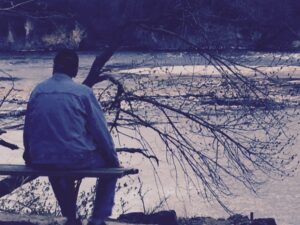
Still
Sitting quietly is one of the best ways to enjoy nature. We do it often, but usually, it’s not in the woods. We sit very still on our back deck, especially during pleasant weather. More often our sitting is at our kitchen table, where we watch our resident wild turkeys and deer prance around the yard, and songbirds snatch seeds from our feeders. Once we watched a squirrel approach with a walnut in its mouth. Just outside our window, it buried the nut.
Animal Senses
The senses of wild animals vary. For example, the turkeys who visit our yard have superb eyesight and hearing but a poor sense of smell and taste. In contrast, deer have relatively poor eyesight but outstanding senses of smell and hearing.
Even animals with poor eyesight notice and react to movement. A deer might stare at an immobile person for some time trying to catch a scent, but at the slightest movement, the animal will bolt.
Stillness
To see the most wildlife, rule out fidgeting. Sit still. To observe the widest range of species, sit very still downwind so any scent wafts from the animal toward the person rather than vice versa.
Rich can sit nearly entirely motionless for long periods. Here are his tricks for being still:
Tips for Stillness and Dark Discoveries
- Have a comfortable seat. He finds sling chairs easy to carry into the woods and comfortable to sit in. Sometimes he just brings a foam rubber pad that’s even easier to carry and insulates his posterior from cold and wet ground.
- Dress extra warmly. Movement causes muscles to work and generate heat. Sitting requires warmer clothing than walking on an equally cold day. In the winter Rich wears these items:
- Layers starting with a base layer. We once called them Long Johns. Over them goes a pair of pants and over them goes insulated bib overalls. For his upper body, Rich wears a t-shirt, base layer long-sleeve shirt, light fleece jacket, and, finally, a winter coat.
- Warm footwear. Feet get cold quickly but winter footwear helps keep them toasty. Rich wears a pair of wicking socks under wool socks that fit loosely within his “Pac boots”. These high-top boots have removable felt liners.
- A thick wool stocking cap keeps the noggin warm and a pair of thick mittens does the same for the fingers. When it’s super cold Rich sometimes wears light wool gloves and then slips his hands into mittens, creating a double layer.
Other Comforts for Stillness and
Dark Discoveries
Another useful comfort help is the many types of hand warmers on the market. Some are rechargeable electric devices while others are pouches of material inside a plastic container. Rip open and shake the container. Oxygen reaches chemicals in the pouch, creating heat. Some are made to slip in boots. Others fit inside gloves and some large ones are perfect to stick under clothing to keep a sitting person’s back warm.
Sitting inside and watching wildlife out the window eliminates the need for warm clothes but usually lacks the intimacy that sitting within a prairie or woods provides.
Other Aids
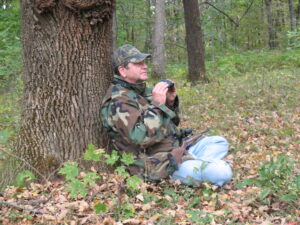
waiting
A pair of binoculars helps view wildlife, but the movement to raise them to the eyes sometimes scares away animals. Rich often wears his hearing aids to accentuate sounds that add to the experience.
Remember the Wonders of Darkness
At Winding Pathways, we sometimes sit outside after dark. As soon as our eyes adjust to low light, we occasionally spot deer, opossums, and raccoons prowling in the yard. The best wildlife viewing is when the moon casts some light. However, the best star viewing is during the moon’s dark phase. That comes with a bonus. Since the stars aren’t spooked by our movement we can make all the noise and motion we want and they stay majestically above us.
So, here’s our suggestion: Go outside and embrace the stillness and dark.
by Winding Pathways | Jan 23, 2025 | Nature
In late autumn 2024, we had only light snow. The thin coverings of snow each revealed a procession of night visitors the next morning in tracks. We got especially excited by one set of tracks. Our possum’s presence! It is our favorite opossum. We hadn’t seen him (or her) for several months and feared that the animal may have been hit by a car or suffered some other death.
The sparse snow cover made excellent tracking conditions. We were delighted to follow our possum’s tracks as they wandered past our bird feeder to our compost bin.
Opossum tracks are distinctive. The animal’s toes are almost semicircular with widely spaced toes. Raccoon toes, in contrast, are more like human toes and are arranged almost in parallel.
-
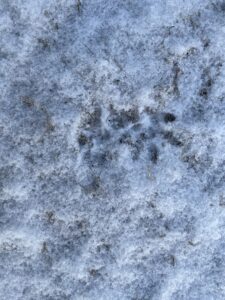
-
note splayed fingers
-
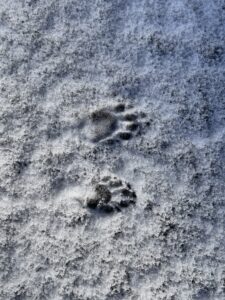
-
Raccoon paws are more like hands.
The possum wasn’t alone. We also discovered that a coyote had passed through our yard, deer had lingered a while and checked out the bird feeder, and a house cat visited, probably seeking a tasty mouse for dinner. We found mouse tracks but no evidence that one of these tiny rodents became the cat’s dinner. Sometimes a fox trots by.
-
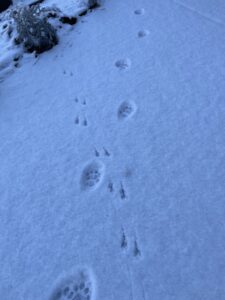
-
Hunting
-

-
Distinctive tracks
-
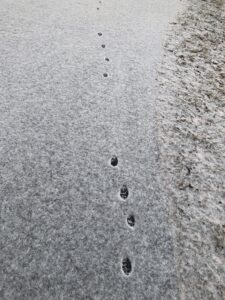
-
Fox usually trot with one paw in front of the other.
Although we have written about tracking before, we find that tracking is fascinating and a good way to enjoy winter outdoors. A light snow creates perfect conditions. The Old Farmer’s Almanac posts a useful guide on how to identify animal tracks. We are happy to re-discover our possum’s presence.
-
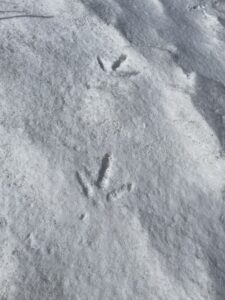
-
Three-pronged turkey tracks.
-
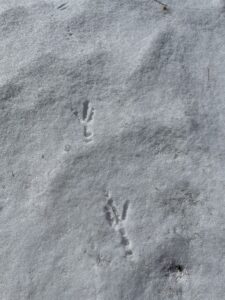
-
Easy to spot
-
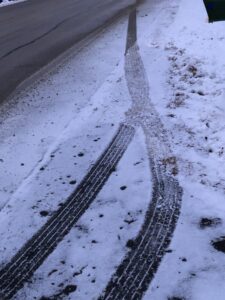
-
Distinctive
















































